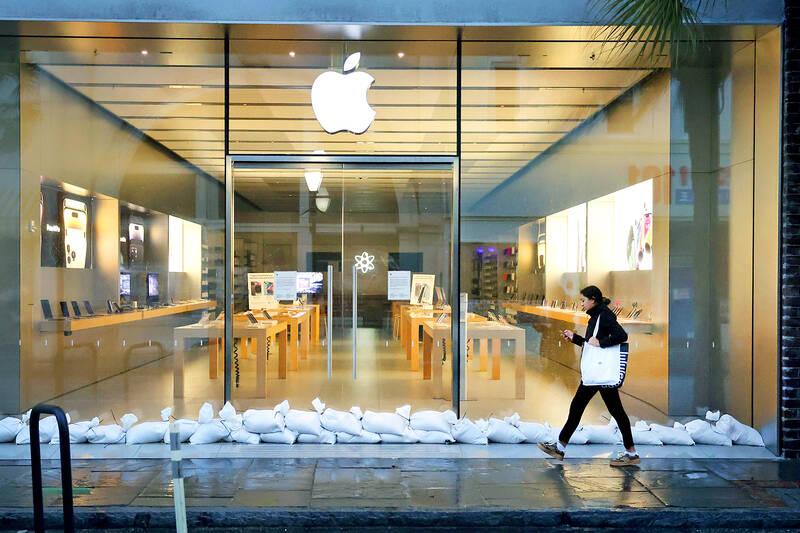Apple Inc vice president of industrial design Evans Hankey is leaving the iPhone maker three years after taking the job, creating a significant hole at the top of the company, people with knowledge of the matter said.
Hankey was named to the post in 2019 to replace Jony Ive, the company’s iconic design chief for two decades. Before taking her current role, Hankey spent several years at Apple reporting to Ive. Since then, she has reported to Apple chief operating officer Jeff Williams.
The departure was announced inside the Cupertino, California-based technology giant last week, with Hankey telling colleagues that she would remain at Apple for the next six months.

Photo: AFP
The company has not named a replacement for Hankey, who oversees several dozen industrial designers.
Her pending exit marks the first time that Apple would be without a de facto design chief since cofounder Steve Jobs retook control of the company in the late 1990s and appointed Ive to the job.
Richard Howarth, a key designer on Ive’s and Hankey’s teams, briefly held the role of head of industrial design, reporting to Ive, from 2015 to 2017.
Apple on Friday confirmed that Hankey is stepping down.
“Apple’s design team brings together expert creatives from around the world and across many disciplines to imagine products that are undeniably Apple,” a spokesman said in a statement. “The senior design team has strong leaders with decades of experience. Evans plans to stay on as we work through the transition, and we’d like to thank her for her leadership and contributions.”
The elegance of Apple’s products — including the then-revolutionary idea of a mobile phone that was just a screen — helped fuel the company’s comeback under Jobs, and it has continued to be a key differentiator under Apple chief executive officer Tim Cook, helping ward off rivals such as Samsung Electronics Co and Amazon.com Inc, and turning Apple into the world’s most valuable business.
The company is on track to approach US$400 billion in sales this year, according to analyst estimates, a new record.
Apple has weathered this year’s tech downturn better than most of its tech peers. Its shares have fallen almost 17 percent this year to date, compared with a 31 percent drop for the tech-heavy NASDAQ Composite Index.
Apple rose 2.7 percent to US$147.27 on Friday.
The void left by Hankey could affect Apple’s future design plans and raises fresh questions about how its products would evolve in the post-Ive era. The company has been working on key new devices, including a mixed-reality headset for next year and augmented reality glasses that would come at a later date. There is also the possibility of an electric vehicle some time this decade.

CAUTIOUS RECOVERY: While the manufacturing sector returned to growth amid the US-China trade truce, firms remain wary as uncertainty clouds the outlook, the CIER said The local manufacturing sector returned to expansion last month, as the official purchasing managers’ index (PMI) rose 2.1 points to 51.0, driven by a temporary easing in US-China trade tensions, the Chung-Hua Institution for Economic Research (CIER, 中華經濟研究院) said yesterday. The PMI gauges the health of the manufacturing industry, with readings above 50 indicating expansion and those below 50 signaling contraction. “Firms are not as pessimistic as they were in April, but they remain far from optimistic,” CIER president Lien Hsien-ming (連賢明) said at a news conference. The full impact of US tariff decisions is unlikely to become clear until later this month

With an approval rating of just two percent, Peruvian President Dina Boluarte might be the world’s most unpopular leader, according to pollsters. Protests greeted her rise to power 29 months ago, and have marked her entire term — joined by assorted scandals, investigations, controversies and a surge in gang violence. The 63-year-old is the target of a dozen probes, including for her alleged failure to declare gifts of luxury jewels and watches, a scandal inevitably dubbed “Rolexgate.” She is also under the microscope for a two-week undeclared absence for nose surgery — which she insists was medical, not cosmetic — and is

GROWING CONCERN: Some senior Trump administration officials opposed the UAE expansion over fears that another TSMC project could jeopardize its US investment Taiwan Semiconductor Manufacturing Co (TSMC, 台積電) is evaluating building an advanced production facility in the United Arab Emirates (UAE) and has discussed the possibility with officials in US President Donald Trump’s administration, people familiar with the matter said, in a potentially major bet on the Middle East that would only come to fruition with Washington’s approval. The company has had multiple meetings in the past few months with US Special Envoy to the Middle East Steve Witkoff and officials from MGX, an influential investment vehicle overseen by the UAE president’s brother, the people said. The conversations are a continuation of talks that

Alchip Technologies Ltd (世芯), an application-specific integrated circuit (ASIC) designer specializing in artificial-intelligence (AI) chips, yesterday said that small-volume production of 3-nanometer (nm) chips for a key customer is on track to start by the end of this year, dismissing speculation about delays in producing advanced chips. As Alchip is transitioning from 7-nanometer and 5-nanometer process technology to 3 nanometers, investors and shareholders have been closely monitoring whether the company is navigating through such transition smoothly. “We are proceeding well in [building] this generation [of chips]. It appears to me that no revision will be required. We have achieved success in designing